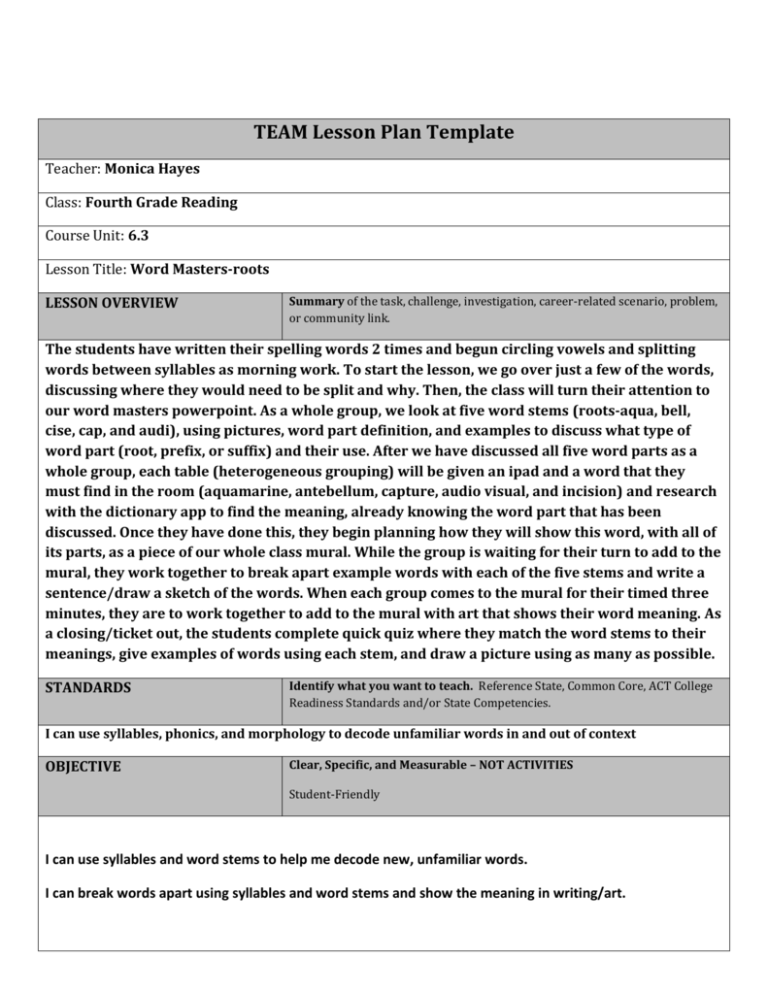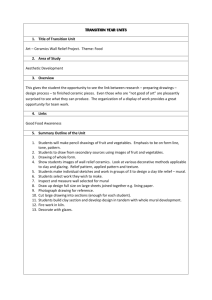TEAM Lesson Plan Template - Arts Education Tennessee Arts
advertisement

TEAM Lesson Plan Template Teacher: Monica Hayes Class: Fourth Grade Reading Course Unit: 6.3 Lesson Title: Word Masters-roots LESSON OVERVIEW Summary of the task, challenge, investigation, career-related scenario, problem, or community link. The students have written their spelling words 2 times and begun circling vowels and splitting words between syllables as morning work. To start the lesson, we go over just a few of the words, discussing where they would need to be split and why. Then, the class will turn their attention to our word masters powerpoint. As a whole group, we look at five word stems (roots-aqua, bell, cise, cap, and audi), using pictures, word part definition, and examples to discuss what type of word part (root, prefix, or suffix) and their use. After we have discussed all five word parts as a whole group, each table (heterogeneous grouping) will be given an ipad and a word that they must find in the room (aquamarine, antebellum, capture, audio visual, and incision) and research with the dictionary app to find the meaning, already knowing the word part that has been discussed. Once they have done this, they begin planning how they will show this word, with all of its parts, as a piece of our whole class mural. While the group is waiting for their turn to add to the mural, they work together to break apart example words with each of the five stems and write a sentence/draw a sketch of the words. When each group comes to the mural for their timed three minutes, they are to work together to add to the mural with art that shows their word meaning. As a closing/ticket out, the students complete quick quiz where they match the word stems to their meanings, give examples of words using each stem, and draw a picture using as many as possible. STANDARDS Identify what you want to teach. Reference State, Common Core, ACT College Readiness Standards and/or State Competencies. I can use syllables, phonics, and morphology to decode unfamiliar words in and out of context OBJECTIVE Clear, Specific, and Measurable – NOT ACTIVITIES Student-Friendly I can use syllables and word stems to help me decode new, unfamiliar words. I can break words apart using syllables and word stems and show the meaning in writing/art. ASSESSMENT/EVALUATION Students show evidence of proficiency through a variety of assessments. Aligned with the Lesson Objective Formative/Summative Performance-Based/Rubric Formal/Informal Whole Group Discussion/ Notes on Word Stems- Formative Breaking Apart, Sentences, and Sketches of Five Word Stems- Formative Mural- Formative Quiz- Summative MATERIALS Aligned with the Lesson Objective Rigorous & Relevant Spelling and Word Masters Notes Sheet Group Role Cards PowerPoint Presentation iPads (dictionary app) Break Apart/Sentence and Sketch Paper Chart Paper Paint, Brushes, Cups, Plates Quiz Motivator/Hook ACTIVATING STRATEGY An Essential Question encourages students to put forth more effort when faced with a complex, open-ended, challenging, meaningful and authentic questions. How might you use what we know about syllable and word parts to decode new, unfamiliar words? Step-by-Step Procedures-Sequence INSTRUCTION Discover/Explain – Direct Instruction Modeling Expectations – “I Do” Questioning/Encourages Higher Order Thinking Grouping Strategies Differentiated Instructional Strategies to Provide Intervention & Extension I Do: The teacher connects the objectives and activity to our reading and decoding words. Then, the teacher leads the class in syllabication of the spelling list. She will then introduce the five word parts, giving information such as meaning, word part, and examples. GUIDED & INDEPENDENT PRACTICE “We Do”-“You Do” Encourage Higher Order Thinking & Problem Solving Relevance Differentiated Strategies for Practice to Provide Intervention & Extension We Do: The class splits into groups to find their word, break it apart, and research the meaning. They will then use their research to add to a class mural with a picture showing the word’s meaning. You Do: With the table group, students will break apart words using all five stems. They will also write sentences and draw sketches with each word stem. CLOSURE Reflection/Wrap-Up Summarizing, Reminding, Reflecting, Restating, Connecting At the end of the lesson, students will complete a quiz that functions as a quick check of understanding. CROSS-CURRICULAR CONNECTIONS Reading Art Writing Speaking/Listening NOTES: The groups are heterogeneous, and role cards (Understanding Coordinator, Creative Coach, Research Representative, and Materials Manager) are given intentionally to provide success for all students.










